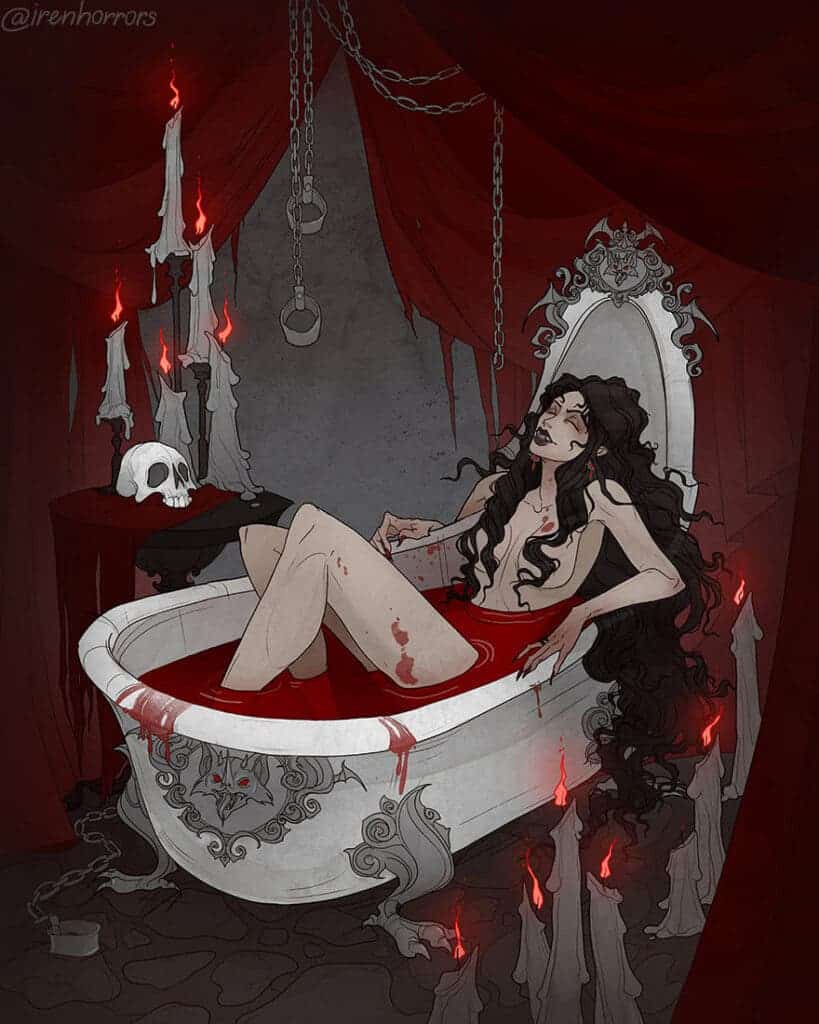
On a dark and cold night on December 29, 1610, soldiers stormed the Hungarian castle of Csejte and arrested Countess Elisabeth Báthory and her servants. What they found inside shook them to their bones and, in the coming months, as her trial unfolded, an entire kingdom would lose sleep over the countess’ vile crimes.
Báthory is today remembered as one of the most cold-blooded and prolific killers in history. She reportedly was responsible for the torture and murder of 600 young girls and women. Indeed, even Guinness World Records lists her as the foremost female serial killer that we know of. While the number of victims in itself is mindblowing, it’s the cruel manner in which these crimes were carried out that would earn Báthory infamous nicknames, such as the Blood Countess or female Dracula.
Today, it is almost an impossible task to separate Báthory’s life from myth. There are many legends in which the countess is a prominent figure in folklore, literature, music, film, and video games. The most commonly encountered motif of these stories was that of the countess bathing in her victims’ blood as a sort of satanic fountain of youth to retain beauty and youth.
However, there is absolutely no credible evidence that suggests the countess actually took blood baths, although it wouldn’t be unheard of. Modern villain Vladimir Putin routinely bathes in the blood from Maral stag antlers, which is extracted while the stag is still alive. The dubious procedure supposedly boosts male health and sexual potency, as well as improves the cardiovascular system and rejuvenates the skin. There’s no evidence any of this works.
But back to Countess Báthory and her nerve-wracking, but oddly fascinating life.
The making of a Blood Countess

Elizabeth Báthory was born in 1560 in the Kingdom of Hungary in a noble family with a long history and close ties with other very powerful families across Europe. For instance, both her great-uncle and grandfather were each voivode of Transylvania, then part of the grand Kingdom of Hungary. From her mother’s side, Elizabeth Báthory was the niece of Stephen Báthory, who was king of Poland for 53 years. Her older brother, Stephen Báthory, served as the judge royal of Hungary for five decades, the second-highest judge in the entire kingdom, second only to the palatine. This was an immensely powerful family, which serves to explain the impunity with which Báthory would go on to commit her many heinous crimes.
We don’t know much of anything about Elizabeth’s childhood and upbringing, but a few particular aspects stand out, foretelling the horrors to come. According to TIME-LIFE’s The Most Notorious Serial Killers, Elizabeth suffered from epilepsy, which at the time would often be treated by rubbing blood from a non-epileptic person on the lips of the patient.
In her book Royal Pains, author Leslie Carroll mentions that young Báthory would often be forced to witness violent punishments executed by her family’s henchmen. Carroll also mentions Satanic worshiping and witchcraft were taught in Báthory’s family. However, none of these claims are substantiated by evidence and are probably the result of hearsay and embellished rumors that have survived in all sorts of texts, like a broken game of telephone.
What’s at least certain about this nebulous period of her life is that Elizabeth Báthory was raised in luxury and privilege. Like other young girls and women of her rank, Elizabeth was well-educated. She was raised a Calvinist Protestant and could speak Hungarian, German, Latin, and Greek.
In 1573, 13-year-old Elizabeth was engaged to Count Ferenc Nádasdy, one of the wealthiest men in the kingdom. The two married when she was 15 and Nádasdy was 19. Because he was of lower rank, Nádasdy took the surname Báthory and Elizabeth officially became a countess. Nádasdy’s wedding gift to his new wife was the Castle of Csejte, located in the Carpathian Mountains, in modern-day Slovakia. It is in this wretched castle that the countess supposedly unleashed her blood-thirsty killing spree.
Just a few years after they were married, Ferenc was made the commander in chief of the Hungarian army, which at the time was at war with the mighty Ottoman empire. Elizabeth was solely in charge of managing the castle and its many estates, which included seventeen adjacent villages.
As part of her duties, while her husband was away at war, Elizabeth was supposed to provide medical care and support to destitute citizens, whose households would often be plundered and families murdered by marauding Ottomans on their way to Vienna. But, in reality, she probably was much worse to her people than the Ottomans.
A legendary killing spree
According to surviving testimonials from subsequent trials from her closest servants, countess Báthory performed all manner of vile and unspeakable acts of savagery. If you have a weak heart for cruelty I would suggest skipping the next few paragraphs.
She would beat servants so badly that the blood splattered on the walls and beds had to be soaked up with ashes and cinders. Servants were burned with red-hot keys, coins, and all manners of metal objects and in the most painful ways, such as ironing the soles of the feet or sticking burning iron rods into the victims’ vagina. Servants often had their lips and tongues stitched together, others were forced to stand in tubs of ice water up their necks until they died of hypothermia.
Some torture sessions were purely diabolical. According to one account, the countess forced servants to cook and eat their own flesh, usually from the buttocks. Needles, knives, burning candles, and all manner of pain-inducing objects were used to lacerate servants’ genitals. One servant girl was stripped naked, covered in honey, and left outside to be bitten by ants, wasps, bees, and flies. Dead bodies were found in the gardens, grain pits, and orchards on the castle’s domain and adjacent properties.
Báthory is famous for bathing in the blood of her victims, but that part of her lore is most certainly false. The claim first appeared in 1729 in one of the works of Jesuit scholar László Turóczi, more than a century after the countess committed murder.

Ferenc died in 1604 aged 49 after nearly three decades of marriage to Báthory. His standing in the kingdom had protected the countess from prosecution but now that he was dead, Báthory’s reign of terror at Csejte could no longer be ignored. Lutheran minister István Magyari was among the most vocal critics calling for the immediate arrest of the countess, but it wasn’t until 1610 that King Matthias II assigned notaries András Keresztúry and Mózes Cziráky to conduct a formal investigation and finally bring the countess to justice.
During this time, the countess’s cousin, György Thurzó, was the count palatine of Hungary — the highest-ranking position in the country, second only to the king. If a king was not yet of age, the palatine would rule as king regent. But even his immense power could not save Báthory, especially after it came to the court’s attention that starting in 1609 some women with noble connections died in dubious circumstances in Báthory’s company. That was just too much.
The count palatine took depositions from hundreds of people living close to her estate. This was a draining task for the investigators, who had to listen to one horror story after the next. The evidence was overwhelming and the testimonies suggest more than 600 girls were killed by Báthory with the help of her servants. Girls as young as ten were abducted by the countess, beaten, and mutilated, before being left to die of freezing or starvation.

Finally, on December 30, 1609, Báthory and her servants were arrested. Two years later, the four servants were put on trial, tortured to extract testimonies about their mistress, and executed. Báthory’s noble blood yet again saved her though. She was put under house arrest at her castle in Csejte, where she spent the rest of her days until she died peacefully in her sleep on August 21, 1614, aged 54.
Initially, the countess’ body was buried at the local church of Csejte, but due to villagers’ uproar, the body was moved to her birth home at Ecséd. The exact location of her grave is unknown to this day. Elisabeth Báthory birthed at least five children, although some reports suggest she had another that died during infancy. Her children inherited all her estate and possessions.
Dracula and the Blood Countess: myth and legend

Much of what we know today about Báthory is very shaky, to say the least. It is very difficult to separate fact from fiction, especially since starting with the 18th century her story inspired numerous works of fiction, much like how the real-life Walachian ruler Vlad the Impaler was immortalized as the fictitious antihero Count Dracula by Bram Stoker. Curiously, Dacre Stoker, Bram’s great-grandson, used Countess Elizabeth Báthory as the main antagonist in his 2009 novel Dracula the Undead.
Some scholars, such as Hungarian authors László Nagy and Dr. Irma Szádeczky-Kardoss, even claim that Báthory was the victim of a conspiracy, arguing that her charges were largely politically motivated. The Báthory family was extremely wealthy and powerful, and King Matthias owed a large debt to the countess, which was erased following her arrest in exchange for sparing her life.
Báthory was Calvinist during an age when the Lutheran Church started exerting a lot of pressure on other faiths. What’s more, all the people who testified against her said that they had never witnessed her commit murder or other crimes with their own eyes, but they knew someone who did. That’s pretty suspicious, to say the least.
There’s a real possibility that all the gruesome stories we’ve heard about the countess are merely slander, meant to allow those in her inner circle, including close kin, to take control of her lands and many riches. But there was probably also a sliver of truth to her murderous reputation. It was common for people of her rank to be well above the law all across the world, not just in Hungary. Like other powerful figures of her time, she could have easily killed lowly peasants and gotten away with it — and she probably did just that, countless times with sadistic glee.





